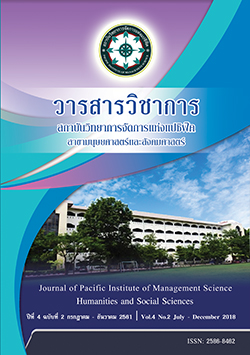Development of a Continuous Care Mode for Pregnant Women with Preterm Labor in Kumphawapi Hospital, Udonthani Province
Keywords:
Continuously Caring, Pregnant Women, Preterm LaboAbstract
This action research aimed to develop and investigate a Continuously Caring Model for pregnant women with preterm labor in Kumphawapi Hospital, Udonthani Province. The concept of Continuously Caring and Deming Cycle was used to improve the quality of midwifery practices. Continuously Caring concept consists of 3 points: continuity of data, continuity of management, and continuity of data relationship. The Deming’s Cycle comprises four–step model which was applied in this action research. The first step was analysis of problems and situations . The second step was to develop Continuously Caring Model and it then was tested on twenty-five pregnant women with preterm labor and ten professional nurses. The third step was to investigate and evaluate the model. After the first 3 steps, the findings showed that the percentage of pregnant women with preterm labor who repeated cycles of treatment was twenty eight. Twenty percentage of the preterm birth rate was reported. The risks of preterm labor were having sexual intercourse without using a condom and working hard during pregnancy. Professional nurses could follow all of the activities which were created in the model. The context of model was cleared ( = 4.22, SD = 0.44). The context of the present model was clearer than the previous guidelines (
= 4.22, SD = 0.44). There were benefits to the organization when evaluated the model (
= 4.22, SD = 0.44). The last step was related to the PDCA cycle, to improve the model. There are suggestions that Continuously Caring Model can be effectively used in practice and it should be imposed as a policy. The model should be monitored, evaluated and improved to be clear and appropriate for each organization.
References
กัลยา มณีโชติและนิจ์สากร นังคลา. (2560). การพัฒนารูปแบบการดูแลหญิงตั้งครรภ์ที่มีภาวะเจ็บครรภ์คลอดก่อนกำหนดโรงพยาบาลมหาราชนครศรีธรรมราช. ปีที่ 44 ฉบับที่ 2, พฤษภาคม-สิงหาคม: 7-25.
ธราธิป โคละทัต , จันทิมา จรัสทอง. (2560). การบริหารยุทธศาสตร์เพื่อลดภาวะคลอดก่อนกำหนด : โครงการและตัวชี้วัดผลสำเร็จ. กรุงเทพฯ: ห้างหุ้นส่วนสามัญ พี พี.พริ้นท์.
ปิยะพร ศิษย์กุลอนันต์. (2550). การพยาบาลสตรีที่มีภาวะเสี่ยงต่อการเจ็บครรภ์คลอดก่อนกำหนด. Journal of nursing science. Vol.25 No.2, May-August: page 4-12.
พรศิริ เสนธิริ สุดใจ ศรีสงค์ รัศมีแข พรหมประกายและมณีรัตน์ เพิ่มชาติ. (2559). การพัฒนารูปแบบการพยาบาลหญิงตั้งครรภ์เพื่อป้องกันการคลอดก่อนกำหนด. Journal of Nursing and Health Care. Vol.34 No.2, April-June: page 164-173.
เวชระเบียนงานห้องคลอดโรงพยาบาลกุมภวาปี จังหวัดอุดรธานี (2560). รายงานสถิติแม่และเด็ก ประจำปี 2558-2560.: งานห้องคลอดโรงพยาบาลกุมภวาปี อุดรธานี.
สายฝน ชวาลไพบูลย์. (2553). ตำราการคลอดก่อนกำหนด Preterm labor. กรุงเทพฯ: พี.เอ.ลิฟวิ่ง.
สายฝน ชวาลไพบูลย์, สุจินต์ กนกพงศ์ศักดิ์. (2554). ภาวะเจ็บครรภ์คลอดก่อนกำหนดและภาวะน้ำเดินในครรภ์ก่อนกำหนด. เวชบันทึกศิริราช. 4(2), 25-39.
สุธาสินี โพธิจันทร์.(2558). PDCA หัวใจสำคัญของการปรับปรุงอย่างต่อเนื่อง (online). จาก URL;http:www. Ftpi.or.th /2015/2125.
สำนักงานสาธารณสุขจังหวัดอุดรธานี. (2560). รายงานตัวชี้วัดงานอนามัยแม่และเด็ก. จาก URL;http:www.udo.moph.go.th/thepost/upload.
เอมพร รตินพร. (2559). การดูแลต่อเนื่อง: หัวใจในการพัฒนาคุณภาพการปฏิบัติการผดุงครรภ์. กรุงเทพฯ: วัฒนาการพิมพ์.
Khashu,M., Narayanan, M., Bhargava,S., & Osiovich,H. (2009). Perinatal outcomes associated with preterm birth at 33 to 36 weeks gestation: A population-based cohort study.Pediatrics, 123(1), 109-113.
Downloads
Published
Issue
Section
License
บทความที่ได้รับการตีพิมพ์เป็นลิขสิทธิ์ของ สถาบันวิทยาการจัดการแห่งแปซิฟิค
ข้อความที่ปรากฏในบทความแต่ละเรื่องในวารสารวิชาการเล่มนี้เป็นความคิดเห็นส่วนตัวของผู้เขียนแต่ละท่านไม่เกี่ยวข้องกับสถาบันวิทยาการจัดการแห่งแปซิฟิค และคณาจารย์ท่านอื่นๆในสถาบันฯ แต่อย่างใด ความรับผิดชอบองค์ประกอบทั้งหมดของบทความแต่ละเรื่องเป็นของผู้เขียนแต่ละท่าน หากมีความผิดพลาดใดๆ ผู้เขียนแต่ละท่านจะรับผิดชอบบทความของตนเองแต่ผู้เดียว







